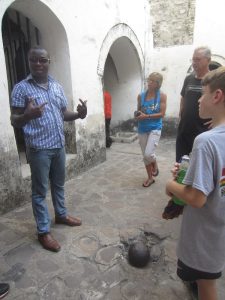Our stay in Ghana also held ominous undercurrents of a dark history, but we felt a bright present and future as well during our brief stay. We spent an afternoon in Nima, a mostly Muslim neighborhood in Accra, learning about a project getting kids involved in painting. Local painters volunteer their time, teaching kids how to paint as an afterschool activity. Once the students know how to hold a brush and mix colors, they work on a mural together with their teachers. These painters come from a variety of backgrounds; for example, Nicholas (pictured below in front of one of the murals) works as a sign painter, crafting everything from barbershop signs to mural-size political advertisements. Another painter we met graduated from art school in Kumasi; a third artist sold his work on the side of the main road into Nima. Their murals add a sparkly layer of interest to an already vibrant part of town.



We did travel to one of the “slave castles,” Elmina, about 73 miles west of Accra. This took us four hours by car. (The highway leading out of Accra is good, but is not very long yet; any accident brings traffic to a halt—and there are a lot of accidents.) Our guide Alex gave us the facts without embellishment: at the height of its operations, Elmina exported 10,000 slaves per year. They were kept in cramped quarters with no plumbing or ventilation. Alex gave us the comparative experience of being momentarily imprisoned in a cell for misbehaving Dutch soldiers and in one for people captured and sent as slaves to the Americas. He made his point well. The cannonball in the courtyard (see picture below) was attached to slaves who tried to run; they were subsequently kept in the courtyard under the hot sun and starved to death. We know the history, but being there and hearing how slavery affected people physically and emotionally was unspeakably horrifying. I was proud to hear of the Obamas’ visit to Cape Coast Castle down the coast (our driver had escorted their security detail in preparation for their arrival).




Leave a Reply